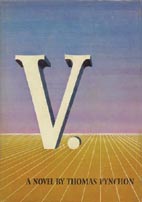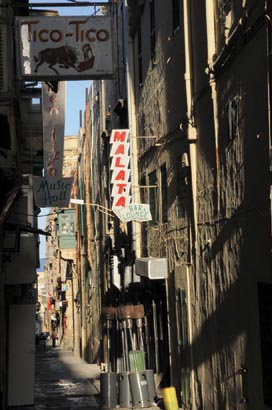Last year, Penguin announced that Thomas Pynchon is to publish his next novel, Bleeding Edge, in autumn. Set in Manhattan's Silicon Valley, it marked Pynchon’s literary return to New York City, where he has not ventured since his début, V., published 50 years ago last year.
publish his next novel, Bleeding Edge, in autumn. Set in Manhattan's Silicon Valley, it marked Pynchon’s literary return to New York City, where he has not ventured since his début, V., published 50 years ago last year.
In the intervening years, Pynchon has journeyed far and wide: Southern California (The Crying of Lot 49 and Inherent Vice), Northern California (Vineland), Chicago (Against the Day), the American colonies (Mason & Dixon), and pretty much all of Europe, Harvard Square, Namibia, and Siberia (Gravity’s Rainbow).
V. ends a long and tortuous journey in Valletta.
Many people have no idea what V. is about – even though they may have read it twice.
It may be about Benny Profane, a hopeless schlemiel who, having been discharged from the Navy, bounces around New York City with a comically harmless gang called the Whole Sick Crew, spending a good amount of time in the aforementioned crocodilian pursuit.
Or the novel could be about Herbert Stencil, the son of a prominent British consular official, Sidney Stencil, who had “died under unknown circumstances in 1919 while investigating the June Disturbances in Malta”.
Stencil’s entire existence is focused on the hunt for V., a classic novelistic quest-without-resolution. V. may be a person, or may be a place, though it could also be neither: Pynchon calls it, at one point, “a remarkably scattered concept” and, at another, “the ultimate Plot Which Has No Name”.

The novel alternates between episodes featuring Benny, Stencil and other members of the Whole Sick Crew (including Profane’s sidekick Pig Podine) in 1956 (with a few minor flashbacks), and a generation-spanning plot which comprises Stencil’s attempts to unravel the clues he believes will lead him to “V.” (or to the various incarnations thereof). Each of these “Stencilised” chapters is set at a different moment of historical crisis; the framing narrative involving Stencil, “V.”, and the journals of Stencil’s British spy/diplomat father threads the sequences together. The novel’s two storylines increasingly converge in the last chapters (the intersecting lines forming a V-shape, as it were), as Stencil hires Benny to travel with him to Malta.
There is a whole series of Vs = Chapter three, set among the British community in Egypt toward the end of the 19th century, which consists of an introduction and a series of eight relatively short sections, each of them from the point of view of a different person. The eight sections come together to tell a story of murder and intrigue, intersecting the life of a young woman, Victoria Wren, the first incarnation of V.
Only marginally part of the Stencil/V. material, this chapter follows Benny and others, as Benny has a job hunting alligators in the sewers under Manhattan. It figures in the Stencil/V. story in that there is a rat named “Veronica” who figures in a subplot about a mad priest – Father Linus Fairing, S.J. – some decades back, living in the sewers and preaching to the rats; we hear from him in the form of his diary.
In Florence in 1899, Victoria appears again, briefly, but so does the place name “Vheissu”, which may or may not stand for Vesuvius, Venezuela, a crude interpretation of wie heißt du, translating into who are you in the German language, or even (one character jokes) Venus.
Fausto Majistral, a Maltese civilian suffering under the German bombardment and working to clear the rubble during World War II writes a long letter to his daughter Paola, who figures in the Benny Profane story; the letter comes into Stencil’s hands. The letter includes copious quotations from Fausto’s diary. Besides the place name Valletta, V. figures in the story as an old – or possibly not-so-old – woman crushed by a beam of a fallen building.
As the Royal Navy mass on Malta in the early stages of the Suez Crisis, Stencil arrives with Benny in tow, searching for Fausto Majistral.
The last chapter is a flashback to Valletta when Stencil Sr. was still alive. After World War I he is sent to Malta to observe the various crises going on involving the natives and their desire for independence. He is implored by Majistral’s wife (who is pregnant with Fausto) to relieve him of his duties as a double agent because she fears for his life.
Stencil Sr. meets Veronica Manganese or V and implicitly has sex with her (she is now largely made up of artificial limbs). It is revealed they had trysted in Florence after the riots. He finds out that Fausto is having an affair with her as well.
Linus Fairing is also working as a double agent for Stencil, and when he leaves for America, having tired of the life of a spy, Stencil’s purpose for being in Malta is null.
V. releases Stencil from her auspices and Majistral as well.
Stencil sails off into the Mediterranean and a waterspout blows the ship up into the air, then down into the depths, not too dissimilar from the conclusion of another American masterpiece, Moby Dick, also a sailor’s story.
That’s the storyline, if there is anything like that in this picaresque novel. Not many people may have read the novel, difficult to read as it is, and not many knew of the Pynchon connection with Valletta and Malta.
Last week, Din l-Art Helwa held its monthly lecture and this time it was delivered by Professor Peter Vassallo, an eminent authority on British literature, who spoke about the connection between Pynchon and Strait Street.
Strait Street is very much in the news today especially since it seems that Valletta 2018 will resolve itself in the regeneration of this narrow road with a colourful history.
It arouses different memories in different people. Simone Mizzi, DLH head, who like Prof. Vassallo hails from Valletta, spoke mostly about her memories which consisted mainly of smells.
Peter Vassallo had a different memory – that of a small boy who was told by his family not to go anywhere near Strait Street, until the day, in the 1950s, the same years that Pynchon was in Malta prior to the Suez invasion, when, together with his father and his brother, they had to walk through Strait Street to avoid the St Dominic festa. And there, sitting on top of some stairs, was a “blowsy middle-aged woman” who shouted “Joe, come and have a good time”, at which Peter’s brother asked his father (whose name was Joe) “Does this woman know you?” To which his father’s admonition was to tell the boys to look down as otherwise they would go to hell.
With that as an introduction, Professor Vassallo launched into an explanation of the novel, its literary context and of course its Malta and Strait Street connection.
On the literary level, the novel resembles Calvino’s City, or novels by Nabokov, his tutor.
It is ascertained that Pynchon as a seaman in the US navy was in Malta during the Suez build-up, so the Valletta he portrays is a town he knows well, including and especially Strait Street with its bars, brothels and latrine.
Valletta has a double identity, suited to the multi-layers of Pynchon’s novel, the city of history but also the city of myth, the city of authority, religion, statehood and the city under the city, effervescent, vital, such as Strait Street used to be after the sun set.
Among the personages mentioned in this context there was the ubiquitous Kilroy of the “Kilroy was here” graffiti on latrine walls, who somehow gets involved in the quest for V.
“I remember,” though here I am not sure if it was Prof. Vassallo and his own memories or whether he was quoting from Pynchon, “in Palace Square, the Military Police dragging a very drunk sailor who, to prove he was not drunk, paced the slabs at the Main Guard, he believing he was doing so in a straight line, but in reality he was going round in circles.”
The details Pynchon writes about Strait Street have the clear thumbprints of lived experience – the beautiful phrases describing the Metro Club, the stale beer, the sawdust, the bands.
There is much more besides: Pynchon goes back centuries and describes the Phoenician goddess Mara, which has become Maltese for woman.
During question time, a member of the audience pointed out that he remembers Strait Street from the 1960s and it was definitely not as it is being romanticised today. It was sleazy, full of brothels, women were slave driven into prostitution and exploited.
But other members of the audience said that not much prostitution was carried out in Strait Street proper, but round the corner in other streets, like St Joseph’s Street.